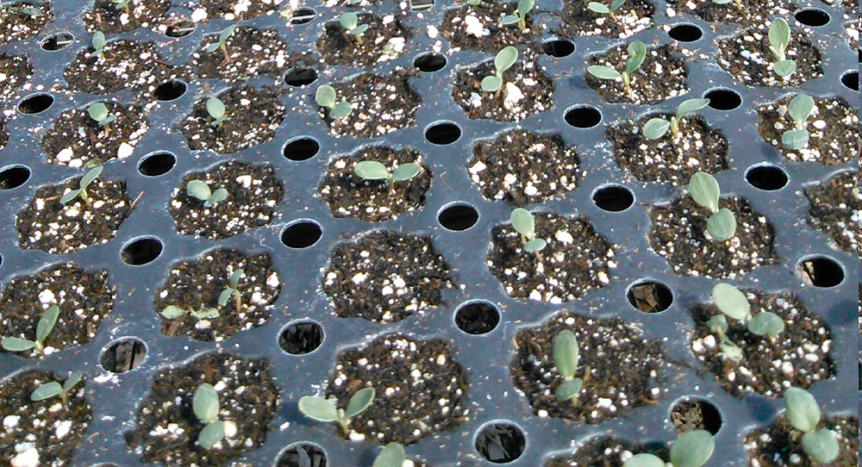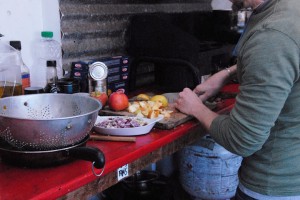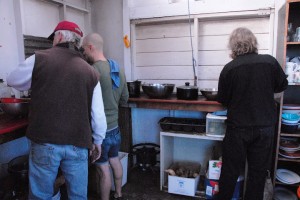In early spring, we have planned our crops for the year–how many beds, how the beds will be rotated, how many plants to a bed. We are sowing seeds in the greenhouse and planting seedlings from the greenhouse in the ground. It is only natural to begin to think about WHO we are growing this food for.
A beautiful part of the CSA model is that we have a relationship through the entire harvest season with people who will be eating the food we grow at Natural Bridges Farm. Equally beautiful, is the possibility that our CSA members will create a relationship with the farmers at Homeless Garden Project and with the farm itself.
When HGP started Santa Cruz County’s first CSA back in the early 1990′s, this connection to the farm where your food is grown was a strong ideal of the CSA model. Since CSA has taken hold in our county and many farms now offer CSA shares, convenience and price have clouded this ideal. We hope Robert’s piece below about his relationship with the farm–his “communion with the farm,” in his words–will revive and make vivid this value of membership in HGP’s CSA program: the opportunity and structure to connect with the farm each week for 23 weeks as you pick up your food.
Communion of Human Spirit and Land: Staying Rooted in Place
It was around 9:20 am when I pulled up to the Farm at Natural Bridges… it was Wednesday morning and it was my shift in the kitchen that got me out of bed that mist filled first light about 6:30. I’m an early riser most often… giving myself time for a French Press full of good dark roast coffee, journaling and if the moment allows, a good sit in meditation. It was an unusually quiet start to the day… Chris and Mike were the only ones there that I could see, other than Lily the farm cat prowling the back forty. I wandered over to the ‘alchemist’s shack’, aka: the kitchen and started to take an inventory of what might be on the menu for the lunchtime gathering. Hmmm… there was cabbage, a few carrots, lots of celery, rice, potatoes, and maybe some greens for a salad? Sounded good. Of course there were other items in the dry goods storage, but I wanted to use up the perishables first. So, I took out my favorite cutting board, selected the sharpest knife that we had and headed out to the side of the kitchen to start slicing and dicing the items for my gourmet lunch du jour.
The fog was damp and cool on the back of my neck and the fields were covered with dewymoisture from the overnight exposure to the ocean mist drifting over the farm. There was a serenity present that morning… something hidden yet salient as the farm slowly started to wake up from its chilled, damp slumber. I looked out over the back forty as if searching for some kind of sign, but the only indication that I received of my presence being acknowledged, were the sparrows flitting about back and forth trying to grab a tidbit or two from the compost pail as I was throwing the discarded scraps of vegetables from my food prepping project. Somehow, that was enough for me as their aviary chicanery brought a smile to my lips. The trainees were at the Depot Station office taking in a workshop and I had the kitchen all to myself. This gave me time to reflect on what keeps me ‘rooted’ here in Santa Cruz, California… to take stock in the elements that bring us into communion with the land around us.
I referred to the kitchen as being an alchemist’s hut… and really, that’s exactly what it is. The kitchen is the central forge of the community, and has been for thousands of years. It’s where we cook our meals, washed our clothes long ago, gather for warmth and settle down with a cup of coffee to catch up with friends. Although the hearth has changed over the years from fireplaces, to wood stoves to gas and electric stoves, the process and outcome is the same; it’s where we draw strength from, and nourishment, both bodily and spiritual, and it is where we find the flame that tends our souls. Where else could one be in the present of ‘spirit’ within a community than an outdoor kitchen that takes in the harvest of the land around it and transforms it into physical, body-centered fare that is meant to sustain us? If you ask some folks, being in the presence of ‘spirit’involves putting one’s hands in the soil, or perhaps planting, cultivating and harvesting the rewards… but for me, it’s the process of taking the fundamental elements of fire, water, earth and air and combining them by means ‘alchemical praxis.’ The end result that which which nourishes both ‘spirit’ and body is food.
So, as everybody lined up to receive the meal, as they pile the food on their plates to feedtheir hunger, I am reminded of the power that emanates from the hearth, our kitchen in the field… our ‘alchemist’s hut’. That is the best feeling on the planet for me and perhaps I inherited that trait from my mother, but the satisfaction that comes from filling someone’s stomach and quelling their hunger, whether by simple or complex savory means… is for me, an utterly spiritual experience. Nowhere else am I myself, who I truly am, other than when I am in the kitchen, by the hearth. That’s an interesting word ‘hearth’, right? From its constituent parts we can parse out the words, ‘Earth’ and ‘heart’ and then begin to see those true connections that underlie the greatest mystery of all… that of the communion of the human heart with the Earth… and where does that take place? Well, for me it’s the kitchen… the ‘alchemist’s shack’ in the middle of The Farm at Natural Bridges. What better place than that to discover your own magic?
I hope that you hold fast to your memories of ‘earthly communion’ when you pick up your CSA box or gather your own harvest from the fields. May your visit be pleasurable and your ‘spirit’ always nourished. And if you ever find yourself passing by the kitchen, stop in and take a look around… talk to the people gathered there, find yourself ‘rooted in this place’, the little farm by the coast in Santa Cruz, California. I believe that you’ll be glad you did. Namaste.
Robert M. Foran is working to complete a BA in Cultural Studies with an emphasis on Environmental Justice as it relates to Race, Class, and Gender at SUNY Empire State College. He has worked in hospice care, with the New York Open Center, and with the Urban Ecology Center in Milwaukee, helping to restore 40 acres of native habitat as well as working with their youth outreach program to inspire them to learn about land stewardship and their role within the community. Originally from upstate New York he now resides in Santa Cruz where he volunteers with the Homeless Garden Project. Find more at www.spiritofcommonspace.wordpress.com







